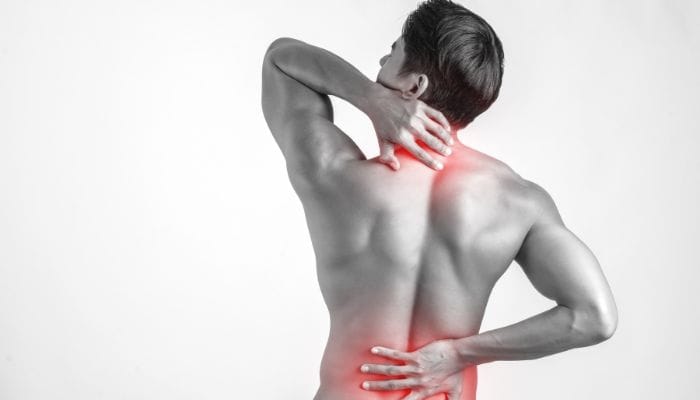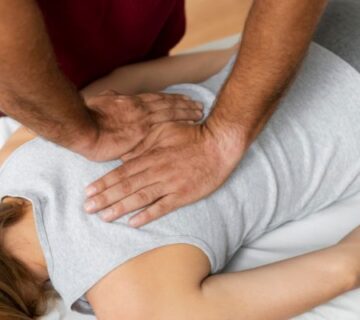Do you experience frequent back pain in your life? If so, you are one among the many searching for the answer to relief. It can strike after hours at a desk, a weekend of heavy lifting, or sometimes for various reasons. The impacts are many—it interrupts your work, your rest, and even the smallest moments of joy, like picking up your child or simply sitting comfortably.
Understanding why your back hurts is the first step to reclaiming control. Is it your posture? A strained muscle? Or could it be something else entirely? This guide dives deep into the common causes and symptoms of both upper and lower back pain. From simple strain to underlying conditions, we’ll help you pinpoint the problem and take steps toward a pain-free life.
Table of contents
Causes of Upper Back Pain
1. Muscle Strain and Overuse
- Repetitive motion: Repeating the same movements, like typing or lifting, can overwork certain muscles.
- Heavy lifting: Lifting heavy objects (or even kids!) improperly can strain the muscles in your upper back.
- Sports or exercise injuries: Working out without proper structure or over workout can lead to pulled or strained muscles.
2. Poor Posture
- Text neck: Constantly looking down at screens causes stress on your upper spine and leads to tightness in the muscles around it.
- Rounded shoulders: Slouching while sitting or standing can force your upper back muscles to work harder than they should.
3. Spine-Related Issues
- Herniated or bulging discs: When the soft discs between your vertebrae shift out of place, they can press on nerves and cause pain.
- Degenerative disc disease: Over time, wear and tear on your spine can result in chronic upper back pain.
- Arthritis: Osteoarthritis in the spine can cause joint inflammation, leading to stiffness and pain in the upper back.
- Scoliosis or alignment issues: Abnormal curvature of the spine can strain the muscles in your back and surrounding area.
4. Injury or Trauma
- Whiplash from car accidents or sports injuries can impact muscles and ligaments in the back.
- Falls or direct blows to the back can damage muscles, bones, or nerves in the upper back area.
5. Medical Conditions
- Fibromyalgia: This condition causes widespread muscle pain, including in the upper back.
- Myofascial pain syndrome: Trigger points in the muscles can cause localized pain to the upper back.
- Osteoporosis: Loss of bone density can lead to fractures in the vertebrae, resulting in upper back pain.
- Shingles (if near the spine): This viral infection can cause burning pain and sensitivity on one side of your back.
6. Lung or Heart Conditions (Rare but Serious)
Though less common, upper back pain could be a sign of something more serious.
- Lung issues like pneumonia or a pulmonary embolism might add to the upper back pain.
- Heart problems such as angina or a heart attack can sometimes cause pain radiating to the upper back—especially in women.
Symptoms of Upper Back Pain
- Aching Pain: That constant ache sitting between your shoulders or along your upper spine.
- Stiffness: Stiff upper back muscles can make bending, twisting, or even stretching very hard.
- Tenderness: Your upper back muscles become so weak, and it hurts when touched.
- Burning Sensation: That heated, tingling feeling running along your back; it’s a possible symptom of nerve irritation.
- Radiating Pain: Upper back pain doesn’t stay in one spot. Sometimes it spreads out to your shoulders, chest, or even your arms.
- Pain When Breathing: If a simple breath combines with heavy upper back pain, it might be pointing to something serious.
- Associated Symptoms: Symptoms like fever, unexplained weight loss, or bowel/bladder problems can be related with upper back pain.
Causes of Lower Back Pain
The cause for lower back pain is mostly similar to that of upper back pain as discussed above. However, below are some additional causes to keep an eye.
- Congenital Spine Issues: Sometimes, people are born with structural problems in their back that lead to discomfort.
- Obesity: Carrying extra body weight puts a constant strain on your back.
- Smoking: Believe it or not, smoking can mess with blood flow to your spine, making healing harder and increase pain.
- Aging: As you get older, muscle elasticity, bone strength, and disc flexibility all decline—making back pain a common companion.
- Chronic Conditions: Conditions like diabetes can sometimes cause back pain as well.
Symptoms of Lower Back Pain
- Pain Traveling to the Legs: Sometimes the pain doesn’t just stay in your lower back—it spreads to your hips, butt, or legs.
- Sharp, Shooting Pain: A sharp pain running down the leg, called Sciatica.
- Tingling or Numbness: You might feel someone pricking with “pins and needles” in your hips, legs and feet along with some numbness.
- Weakness in the Legs: Trying to stand or walk, but your legs feels very tired or weak? Lower back issues could be the reason.
- Pain When Sitting or Sleeping: Sitting for a while or lying in bed might make the pain more worse.
Frequently Asked Questions (FAQs)
1.What are the 3 main causes of back pain?
- Muscle Strain and Overuse: Repetitive motions, heavy lifting, or exercise injuries can strain the back muscles, leading to pain and discomfort.
- Poor Posture: Slouching, rounded shoulders, or constantly looking down at screens can stress the spine and surrounding muscles.
- Spine-Related Issues: Conditions like herniated discs, arthritis, or scoliosis can affect the spine’s alignment, causing pain and stiffness.
2.What causes lower back pain just above the buttocks?
Lower back pain just above the buttocks can stem from several causes. Muscle strain from activities like heavy lifting or repetitive motions is common. Poor posture, such as prolonged sitting or slouching, can also stress this area. Spine-related issues like herniated discs or degenerative disc disease might create pain here. Additionally, conditions like sciatica or obesity-related strain can contribute to discomfort in this region.
3.What diseases start with back pain?
Back pain can be an early symptom of several diseases. Conditions like osteoarthritis and ankylosing spondylitis involve inflammation and degeneration of the spine, leading to pain. Kidney infections and stones can also cause referred pain to the back. Additionally, fibromyalgia, a condition characterized by widespread muscle pain, often starts with back discomfort. It’s important to consult a healthcare professional for an accurate diagnosis if back pain persists.
Back pain doesn’t have to be humped for life. Understanding its causes and symptoms is key to finding relief. Take charge today—adjust your posture, stay active, and don’t hesitate to seek advice from a healthcare professional.
If you are searching for pain management doctors in Dallas, Texas, Contact Spine and Pain Institute.
(Dr. Pritesh Patel here offers advance pain management treatment for back pain).





No comment